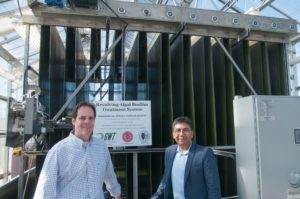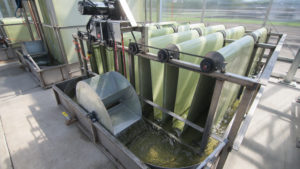Source: Metropolitan Water Reclamation District of Greater Chicago
Funding supports research toward the world’s first commercial scale revolving algal biofilm system to remove nutrients from wastewater
The Metropolitan Water Reclamation District of Greater Chicago (MWRD) and research partners have received a $240,000 grant from the U.S. Department of Energy’s (DOE’s) Office of Energy Efficiency and Renewable Energy (EERE) to continue developing a sustainable nutrient recovery system that uses a unique algae harvesting process.
The EERE funding will support the project team, led by the DOE’s National Renewable Energy Laboratory (NREL) and partners at the MWRD and Iowa State Universityaffiliate startup Gross-Wen Technologies (GWT), Inc., to enhance a phosphorus removal technology known as the revolving algal biofilm (RAB) system. The technology originally developed by GWT at Iowa State University for agricultural applications was then adapted for algae-based treatment of municipal wastewater at the MWRD’s O’Brien Water Reclamation Plant greenhouse in Skokie. The RAB system removes phosphorus, nitrogen, and other nutrients from wastewater, while producing algae biomass from waste nutrients and carbon dioxide captured from the air.
“This critical research collaboration uses algae technology to enhance nutrient removal efficiency for the millions of people who rely on our services each day while protecting the water environment in downstream communities across the country who deserve clean water and healthy aquatic life,” said MWRD President Kari K. Steele. “Thanks to the support from the U.S. Department of Energy, we are harvesting algae for new uses and protecting our water environment.”

Former MWRD Monitoring and Research Asst. Director Tom Kunetz and Principal Environmental Scientist Kuldip Kumar display the revolving algal biofilm treatment system that could change the way nutrients are recovered from water reclamation plants through the help of algae.
EERE announced more than $20.1 million in federal funding for 58 projects supported by DOE’s Office of Technology Transitions Technology Commercialization Fund (TCF). The projects are a part of a larger Department-wide TCF effort, in which 82 projects will receive more than $33 million in federal funding and more than $36 million in matching funds from the private sector. “
“EERE’s Technology Commercialization Fund projects maximize our research investment by strengthening partnerships between DOE’s National Laboratories and the private sector,” said EERE Assistant Secretary Daniel R Simmons, who met with MWRD Executive Director Brian A. Perkovich and other utility leaders in Chicago last fall. “These projects will help us sustain American global leadership in the renewable power, transportation, and energy efficiency sectors by more effectively moving innovations from the labs into the marketplace.”
The grant will support research headed by MWRD Principal Environmental Scientist Dr. Kuldip Kumar, Principal Investigator and NREL Senior Scientist Dr. Jianping Yu, the NREL’s Dr. Michael Cantrell and Co-Principal Investigators, GWT President and Cofounder Dr. Martin Gross.
“Our project addresses a critical efficiency issue in wastewater treatment,” Gross said. “Wastewater treatment facilities around the country are facing increasingly stringent nutrient discharge limits, especially with regards to phosphorus removal, and are looking for new technologies to meet these new permits. We aim to develop strategies to maximize our algal-based wastewater treatment system’s efficiencies to achieve a significant overall nutrient removal outcome and minimized system footprint.”
“This technology may one day allow us to build a true circular economy,” said MWRD Commissioner Debra Shore. “The algae technology converts our wastewater treatment process into a way to capture and reuse energy, nutrients, and other important resources. It’s hard to overstate how exciting this is.”

Algae naturally uptakes phosphorus and nitrogen from water to support its growth through photosynthesis, utilizing the sun as its energy source here at the MWRD’s greenhouse at O’Brien Water Reclamation Plant.
The research will focus on utilizing specific strains of algae that can remove phosphorus more efficiently through a retrofitted version of the RAB system. The RAB reconfiguration will include adding a secondary inoculation reservoir within the system which allows an algae belt to pick up the desired strain(s) of algae, while not exposing the large flow of wastewater to that strain.
“There is a large diversity among algae in their ability to store phosphorus, mostly in the form of polyphosphate granules,” Yu said. “As part of our research goal, we will identify and develop specific algae strains that take up more phosphorus than their growth needs—referred to as luxury uptake—and use them to enhance phosphorus removal efficiency.”
Originally established as a pilot scale project, the RAB used three to six-foot belts in a vertical revolving fashion. That was so successful that the MWRD and GWT partners decided to increase its size to 10 feet to enhance the treatment efficiency. This enabled them to recover more nutrients from the water, increase algal biomass production through a larger biofilm surface area.
The process of cultivating and harvesting algae for the purpose of removing nutrients from wastewater is known as phycoremediation. Algae naturally uptakes phosphorus and nitrogen from water to support its growth through photosynthesis, utilizing the sun as its energy source. The MWRD has an endless supply of water, nutrients, sunlight and moderate temperatures required to grow the algae.
“The revolving algae biofilm system could represent a revolutionary breakthrough in the treatment of wastewater,” said Dr. Kumar. “Thanks to the support of the U.S. Department of Energy, we are taking a major step forward to protect our water environment through sustainable measures that also produce algae for beneficial reuse.”
Under the current system, the MWRD can recover 1.5 pounds per day of dry algae biomass, but if expanded, an increasing amount of algae can be harvested. The algae could remove at least 50 percent of phosphorus from wastewater and can be harvested and commoditized for production of bioplastics, biochemicals, biofuels, pharmaceuticals and dyes; or used as fertilizer or as aquaculture feed.
The partners recently published a research article in Water Environment Research, Journal of the Water Environment Federation that suggests the RAB reactors can serve as an efficient system in wastewater remediation for the removal of total dissolved solids and have filed for a joint patent for this application of RAB technology.
Read the article at mwrd.org

Recent Comments